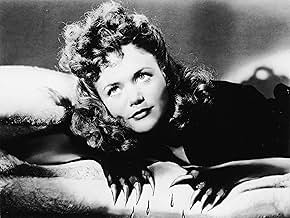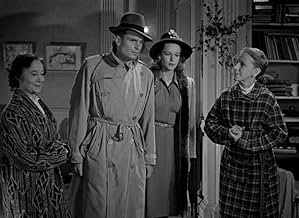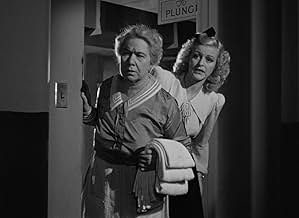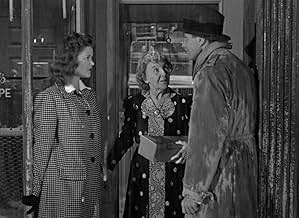VALUTAZIONE IMDb
7,2/10
27.502
LA TUA VALUTAZIONE
Un americano sposa un'immigrata Serba convinta di essere vittima di una maledizione che la trasformerà in una donna gatto se ha rapporti intimi con lui.Un americano sposa un'immigrata Serba convinta di essere vittima di una maledizione che la trasformerà in una donna gatto se ha rapporti intimi con lui.Un americano sposa un'immigrata Serba convinta di essere vittima di una maledizione che la trasformerà in una donna gatto se ha rapporti intimi con lui.
- Regia
- Sceneggiatura
- Star
- Premi
- 2 vittorie e 3 candidature totali
Henrietta Burnside
- Sue Ellen
- (non citato nei titoli originali)
Alec Craig
- Zookeeper
- (non citato nei titoli originali)
Eddie Dew
- Street Policeman
- (non citato nei titoli originali)
Elizabeth Dunne
- Mrs. Plunkett
- (non citato nei titoli originali)
Dynamite
- The Panther
- (non citato nei titoli originali)
Dot Farley
- Mrs. Agnew
- (non citato nei titoli originali)
Mary Halsey
- Blondie
- (non citato nei titoli originali)
Theresa Harris
- Minnie
- (non citato nei titoli originali)
Charles Jordan
- Bus Driver
- (non citato nei titoli originali)
Donald Kerr
- Taxi Driver
- (non citato nei titoli originali)
Connie Leon
- Neighbor Who Called Police
- (non citato nei titoli originali)
Murdock MacQuarrie
- Sheep Caretaker
- (non citato nei titoli originali)
Alan Napier
- Doc Carver
- (non citato nei titoli originali)
Recensioni in evidenza
One doesn't want for a second to take credit away from screenwriter DeWitt Bodeen, one of the most intelligent scenarists the horror film evr had the benefit of. But it's a matter of record that producer Val Lewton, here as on all his horror pictures, was responsible for the initial premise and the screenplay's final draft. And one wonders how much of Lewton - one of those male writers who tended to form his most empathetic bond with his female characters - there is in Irene: like him an eastern european immigrant (she from Serbia, he from Russia, albeit second generation he grew up in an essentially Russian household) living in the very different world of 40's America, both hyper-sensitive (particularly over morbid fantasies regarding cats) and artists of an essentially solitary and modest nature, but prone to fits of violent temper. Certainly, Irene is one of the most vivid and haunting protagonists any horror film ever had. Some critics may disparage the film as inferior to its follow-up, 'I Walked With a Zombie', but although that's a more completely achieved work, none of its characters captures the imagination as Irene does. One scarcely needs to heap more praise on the most celebrated suspense sequences, but the rest of the movie is more than just a set-up for these. It is, for one thing, oneof the supreme evocations of spiritual loneliness in the cinema. As Irene huddles by the doorknob between her and husband Oliver, while the panther in the nearby zoo calls out through the wintery night, this is an evocation of an isolation more than merely physical and tragically irrevocable. Lewton also had on his side, in this instance, the best of his directors, Jacques Tourneur, a sensualist (which could scarecely be said of his successors, Mark Robson and Robert Wise) who makes of the story a sort of tactile poem in the textures of the black fur of Irene's coat, the silk of her stockings, the flakes of falling snow on Irene and Oliver's wedding night, the wet tarmac across which Jane Randolph has to make her scary walk home, the ebony of an Egyptian cat-statue, the fabric of a couch torn by Irene's fingernails, the white enamel of Irene's bath-tub and the gleaming dusky hunch of her wet shoulders as she sits weeping within. This is a subtle movie, but also an intensely physical one. If there is a weak spot, it lies with the casting of Kent Smith as 'good plain Americano' Oliver Reed. His boy next door charm is hopelessly inadequate to the context of Irene's drama and he increasingly seems doltish and blindly insensitive in the blandness of his responses to her torment. The film might have been greater still if Lewton had cast an edgier, fierier actor, one whose incomprehension of Irene might have betrayed its own violent streak and extended the 'cat people' metaphor beyond Irene herself. Think of someone like John Garfield in the role! But Garfield would have been out of Lewton's budget range and one can scarcely harangue the producer for being too modest, in the production of his first quickie horror, for fully grasping how rich a work of film poetry he and his collaborators were in the process of creating. But poetry it is. The horror genre has never produced as much of that as it ought to have done, so for heaven's sake, make the most of this and the other Lewton productions.
I have this theory about the horror films of Val Lewton. It is my contention that these movies caused a sea change in the content and tone of the movies of Alfred Hitchcock. The reason I say this is simple, really: Lewton is the only filmmaker I have ever caught Hitchcock cribbing scenes from. He did it twice. Once from The Seventh Victim (dir. by Mark Robson), which I swear to god provides the first half of the Shower Scene from Psycho. The second from Cat People, which provided the pet store scene in The Birds. This second scene is almost a shot for shot swipe. Both of these steals are evidence that Hitch knew and admired the Lewton movies. More than that, though, there is a change in the subtext of Hitchcock's thrillers after the Lewton movies. The movies he made before them were cut from the Fritz Lang mold of political thrillers. After the Lewton movies, Hitch's movies became more psychosexual in nature. Vertigo, for instance, could easily fit into Lewton's output.
Cat People is the first of the Lewton movies and sets the tone for them. It pretends to be about a McGuffin (serbian were -panthers), but is actually about something else (in this case, frigidity and repressed lesbianism). This represents a huge change in the evolution of the horror movie. Cat People is the first horror movie to explore these themes as central concerns rather than as sub-rosa undercurrents. It also pioneered the techniques of film noir (which as a genre didn't really exist yet). Cat People is strikingly stylized and its effect is of stranding the viewer in the middle of a darkened room with some dreadful beast circling just outside his sphere of perception. This has a hell of an impact--particularly if you have the good fortune to see this in a theater. I'm not going to claim that Cat People is one of the best horror movies ever made (it does have flaws), but it is one of the four most influential horror movies ever made (along with The Cabinet of Dr. Caligari, Psycho, and Night of the Living Dead). But unlike its brethren, its influence spreads corrosively through the entirety of cinema through both film noir and the films of Alfred Hitchcock. You would be hard pressed to find any film short of Citizen Kane or Rashomon that is nearly as influential.
Cat People is the first of the Lewton movies and sets the tone for them. It pretends to be about a McGuffin (serbian were -panthers), but is actually about something else (in this case, frigidity and repressed lesbianism). This represents a huge change in the evolution of the horror movie. Cat People is the first horror movie to explore these themes as central concerns rather than as sub-rosa undercurrents. It also pioneered the techniques of film noir (which as a genre didn't really exist yet). Cat People is strikingly stylized and its effect is of stranding the viewer in the middle of a darkened room with some dreadful beast circling just outside his sphere of perception. This has a hell of an impact--particularly if you have the good fortune to see this in a theater. I'm not going to claim that Cat People is one of the best horror movies ever made (it does have flaws), but it is one of the four most influential horror movies ever made (along with The Cabinet of Dr. Caligari, Psycho, and Night of the Living Dead). But unlike its brethren, its influence spreads corrosively through the entirety of cinema through both film noir and the films of Alfred Hitchcock. You would be hard pressed to find any film short of Citizen Kane or Rashomon that is nearly as influential.
A man called Oliver Reed falls in love with quirky and timid woman who fears an old curse inside her
An American man (Kent Smith) marries a Serbian immigrant called Irena Dubrovna (Simone Simon) , a shy woman who fears that she will turn into the cat person of her homeland's fables if they are intimate together . Dubrovna believes she carries the Serbian curse of the panther . As strange Irena knew strange, fierce pleasures that no other woman could ever feel . She was marked with the curse of those who slink and and court and kill y night . Oliver then sends Irena for treatment with psychiatrist Dr. Louis Judd (Tom Conway) . Meanwhile , Reed finds consolation with his colleague Alice Moore (Jane Randolph) and then jealousy and envy crop out . Later on , rampages take place through community .
Over-the-top classic picture filled with thrills , intrigue , drama , a loving triangle , some moments of shock and results to be pretty entertaining . Atmospheric goings-on dominate this typically tasteful horror study from director Tourner . Suspense , tension and horror is exposed lurking , menacing , harassing in rooms , stairs , doors and a menagerie . Cinematography by Nicholas Musuraca is magnificent , plenty of lights and dark originating an eerie and creepy scenario . The movie was produced by RKO and its most known and famed producer , Val Lewton , the biggest producer of horror classics (I walked with a Zombie , Leopard man , Bedlam , Ghost ship ), plus he produced for director Mark Robson (in Cat people he works as an editor) numerous films (Isle of the dead , seventh victim) with similar technicians and artists . R.K.O. gave Val Lewton only $150,000 to make the film , resulting in "creative" producing . In fact ; because of the incredibly tight budget, sets from Orson Welles' The Magnificent Amberson were re-used . This forced many of the scenes requiring special effects to be done in shadows which many believe increased the suspense of the film . When studio execs insisted that more footage of the panther be included in the movie, Lewton was able to maintain the budget and the suspense of the film by limiting how many scenes the panther could be visibly seen and told the cinematographer to "keep the panther in the shadows" . Thus the panther called Dynamite appeared in another film by the same producers/directors: 'Leopard man' and was only visible in the office and zoo cage .
RKO usual musician , Roy Webb , creates a fine score with the habitual musical director Bakaleinikoff . Excellent and evocative set design at charge of Albert D'Agostino . The picture was stunningly directed by Jaques Tourneur , being filmed in 18 days . The film was such a hit at the box office, the releases of the next two Lewton films I walked with a Zombie and Leopard man were delayed . Torneur knew the imagination was stronger than anything filmmakers could show visually and played on it with breathtaking results . Addicts to RKO horror should no account miss this movie . The flick will appeal to classic cinema moviegoers . Followed by a sequel titled ¨Curse of the cat people¨ by Robert Wise with similar cast as Simone Simon , Kent Smith and Elizabeth Russell . And an inferior remake (1982) by Paul Schrader with Natassja Kinski , John Heard , Malcolm McDowell , Scott Paulin and Ed Begley
Over-the-top classic picture filled with thrills , intrigue , drama , a loving triangle , some moments of shock and results to be pretty entertaining . Atmospheric goings-on dominate this typically tasteful horror study from director Tourner . Suspense , tension and horror is exposed lurking , menacing , harassing in rooms , stairs , doors and a menagerie . Cinematography by Nicholas Musuraca is magnificent , plenty of lights and dark originating an eerie and creepy scenario . The movie was produced by RKO and its most known and famed producer , Val Lewton , the biggest producer of horror classics (I walked with a Zombie , Leopard man , Bedlam , Ghost ship ), plus he produced for director Mark Robson (in Cat people he works as an editor) numerous films (Isle of the dead , seventh victim) with similar technicians and artists . R.K.O. gave Val Lewton only $150,000 to make the film , resulting in "creative" producing . In fact ; because of the incredibly tight budget, sets from Orson Welles' The Magnificent Amberson were re-used . This forced many of the scenes requiring special effects to be done in shadows which many believe increased the suspense of the film . When studio execs insisted that more footage of the panther be included in the movie, Lewton was able to maintain the budget and the suspense of the film by limiting how many scenes the panther could be visibly seen and told the cinematographer to "keep the panther in the shadows" . Thus the panther called Dynamite appeared in another film by the same producers/directors: 'Leopard man' and was only visible in the office and zoo cage .
RKO usual musician , Roy Webb , creates a fine score with the habitual musical director Bakaleinikoff . Excellent and evocative set design at charge of Albert D'Agostino . The picture was stunningly directed by Jaques Tourneur , being filmed in 18 days . The film was such a hit at the box office, the releases of the next two Lewton films I walked with a Zombie and Leopard man were delayed . Torneur knew the imagination was stronger than anything filmmakers could show visually and played on it with breathtaking results . Addicts to RKO horror should no account miss this movie . The flick will appeal to classic cinema moviegoers . Followed by a sequel titled ¨Curse of the cat people¨ by Robert Wise with similar cast as Simone Simon , Kent Smith and Elizabeth Russell . And an inferior remake (1982) by Paul Schrader with Natassja Kinski , John Heard , Malcolm McDowell , Scott Paulin and Ed Begley
Jacques Tourneur directed this Val Lewton production that stars Simone Simon as Irina Dubrovna, a Serbian immigrant working as a fashion artist in New York City who meets Oliver Reed(played by Kent Smith) at the zoo. They fall in love and get married, but run into trouble when she finds herself afraid of intimacy, since she believes the fables and legends of her homeland that indicate she is descended from a cursed line of Cat People, who turn murderous when aroused. He scoffs at this, but when his friend & co-worker Alice(played by Jane Randolph) is stalked by a cat-like creature, he begins to wonder. Meanwhile, Irina sees psychiatrist Dr. Louis Judd(played by Tom Conway) who has designs on Irina himself... Eerie and original film avoids monster movie clichés to create an effective atmosphere of dread. Quite intelligent as well, though requires patience, since it is decidedly different!
At the zoo, Oliver Reed (Kent Smith) sees the mysterious Irena Dubrovna (Simone Simon), who is sketching a black panther. He's intrigued by her--it seems to be love at first sight--and is surprised when she invites him into her apartment for a cup of tea. While in her apartment, he sees an odd statue of a man on horseback, holding a sword-skewered cat high in the air. Dubrovna tells him of her native Serbia, and the legend of unchristian "cat people" who were driven into the mountains. Dubrovna's behavior becomes increasingly odd, and animals often react strangely to her. Could she have something to do with the legend of the cat people?
This was director Jacques Tourneur and producer Val Lewton's first horror/thriller film together (they were to do two others together, I Walked With A Zombie (1943) and The Leopard Man (1943)), and for my money, this is the best of the three. Lewton was famous for understated, atmospheric horror that suggested more than it showed, a style that is also evident in his later collaborations with director Robert Wise (who went on to direct the infamous The Haunting (1963), which is often thought to be a pinnacle of this more "suggestive" style, although it's not a particular favorite of mine).
So what does this mean? Well, a lot of younger horror fans, for whom the oldest film that they are really familiar with in the genre is something like The Texas Chainsaw Massacre (1974) or an even more recent film, might be reluctant to call Cat People a horror film. It is "talky", doesn't contain any graphic violence, and we don't even see a horror creature/villain until just a glimpse near the very end of the film. But it is horror--the talking is centered on a captivating supernatural "myth", there are a lot of creepy, well-photographed scenes laden with heavy shadows, there are a couple exquisite chase/suspense scenes, and there is a lot of complex, dark psychological interaction.
The psychological tension is really the focus, as Lewton and Tourneur's films together are moral parables that function more as a metaphor for horror (rather than the more common flipside, where the horror is more prominent and might be a metaphor for some other kind of philosophical point). In this case, the moral and social situations are varied and complex, but are all focused on romantic relationships, ranging from quick actions taken due to lust, to emotional distancing, adultery and abuse of power. The more one watches the film, the more one is likely to get out of the subtextual messages. They remain more subtextual than they might in modern cinema because of content restrictions imposed by studios in this era (although of course those were a reaction to prevalent cultural attitudes at the time). But in retrospect, the buried nature of the themes is a benefit, at least in this case.
Occasionally, the horrific aspect of these types of films can be too understated, so that they simply become realist dramas. That's not the case here. This is a film that is rewarding on many levels.
A 9 out of 10 from me.
This was director Jacques Tourneur and producer Val Lewton's first horror/thriller film together (they were to do two others together, I Walked With A Zombie (1943) and The Leopard Man (1943)), and for my money, this is the best of the three. Lewton was famous for understated, atmospheric horror that suggested more than it showed, a style that is also evident in his later collaborations with director Robert Wise (who went on to direct the infamous The Haunting (1963), which is often thought to be a pinnacle of this more "suggestive" style, although it's not a particular favorite of mine).
So what does this mean? Well, a lot of younger horror fans, for whom the oldest film that they are really familiar with in the genre is something like The Texas Chainsaw Massacre (1974) or an even more recent film, might be reluctant to call Cat People a horror film. It is "talky", doesn't contain any graphic violence, and we don't even see a horror creature/villain until just a glimpse near the very end of the film. But it is horror--the talking is centered on a captivating supernatural "myth", there are a lot of creepy, well-photographed scenes laden with heavy shadows, there are a couple exquisite chase/suspense scenes, and there is a lot of complex, dark psychological interaction.
The psychological tension is really the focus, as Lewton and Tourneur's films together are moral parables that function more as a metaphor for horror (rather than the more common flipside, where the horror is more prominent and might be a metaphor for some other kind of philosophical point). In this case, the moral and social situations are varied and complex, but are all focused on romantic relationships, ranging from quick actions taken due to lust, to emotional distancing, adultery and abuse of power. The more one watches the film, the more one is likely to get out of the subtextual messages. They remain more subtextual than they might in modern cinema because of content restrictions imposed by studios in this era (although of course those were a reaction to prevalent cultural attitudes at the time). But in retrospect, the buried nature of the themes is a benefit, at least in this case.
Occasionally, the horrific aspect of these types of films can be too understated, so that they simply become realist dramas. That's not the case here. This is a film that is rewarding on many levels.
A 9 out of 10 from me.
Lo sapevi?
- QuizThe horror movie technique of slowly building tension to a jarring shock which turns out to be something completely harmless and benign became known as a "Lewton bus" after a famous scene in this movie created by producer Val Lewton. The technique is also referred to as a "cat scare," as off-screen noises are often revealed to be a startled harmless cat.
- BlooperWhen Irena does not show up at her apartment when Dr. Judd, Oliver, and Alice are waiting for her, they leave. Dr. Judd hides his cane in the apartment to give him an excuse to borrow Oliver's key and go back in for it. Afterward, he leaves the door unlocked so that he can sneak back in, something that is hidden from Oliver and Alice. Yet, after Oliver and Alice are threatened in the office, they call the apartment to warn Dr. Judd that Irena is definitely dangerous and that he should leave.
- Citazioni
Irena Dubrovna: I like the dark. It's friendly.
- Curiosità sui crediti[From the opening credits] "Even as fog continues to lie in the valleys, so does ancient sin cling to the low places, the depression sin the world consciousness." - "The Anatomy of Atavism" - Dr. Louis Judd
- ConnessioniFeatured in Draculeena Presents: Cat People (1960)
I più visti
Accedi per valutare e creare un elenco di titoli salvati per ottenere consigli personalizzati
Dettagli
- Data di uscita
- Paese di origine
- Lingue
- Celebre anche come
- Il figlio della notte
- Luoghi delle riprese
- Azienda produttrice
- Vedi altri crediti dell’azienda su IMDbPro
Botteghino
- Budget
- 134.000 USD (previsto)
- Tempo di esecuzione1 ora 13 minuti
- Colore
- Proporzioni
- 1.37 : 1
Contribuisci a questa pagina
Suggerisci una modifica o aggiungi i contenuti mancanti

Divario superiore
By what name was Il bacio della pantera (1942) officially released in India in English?
Rispondi
































